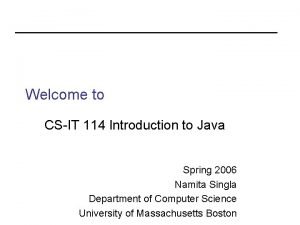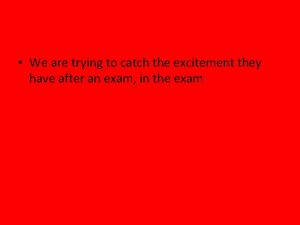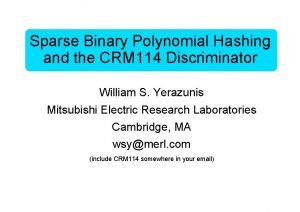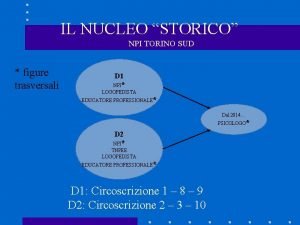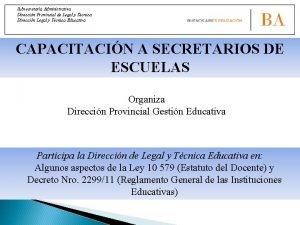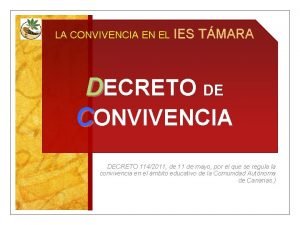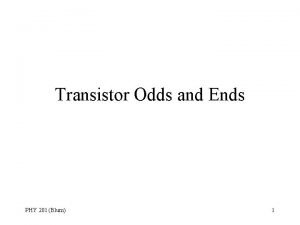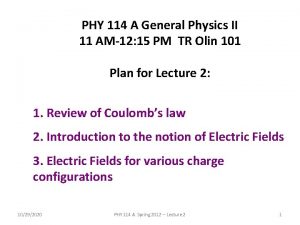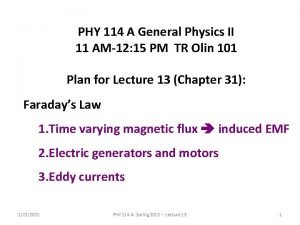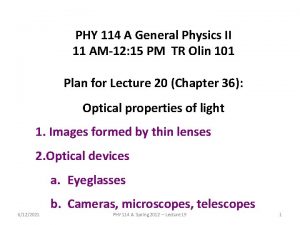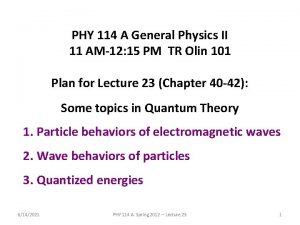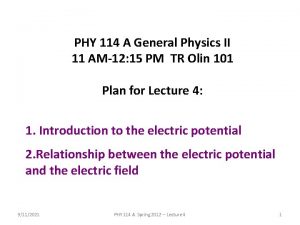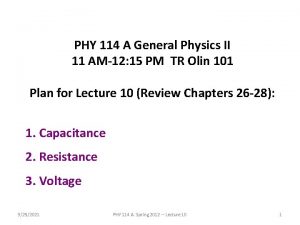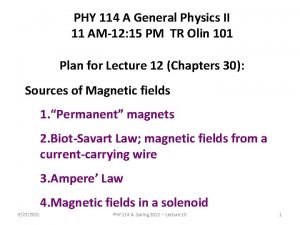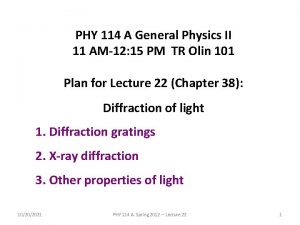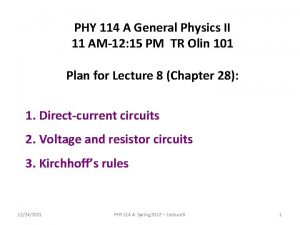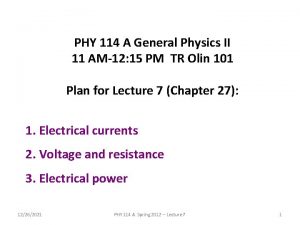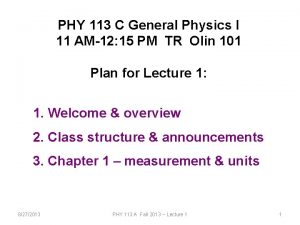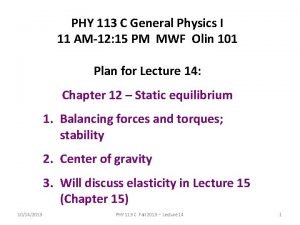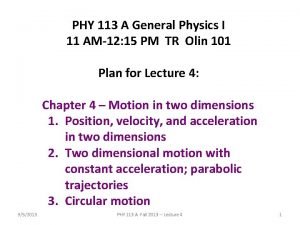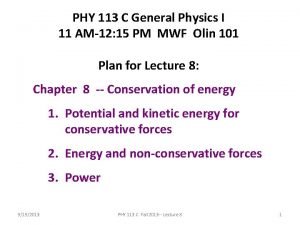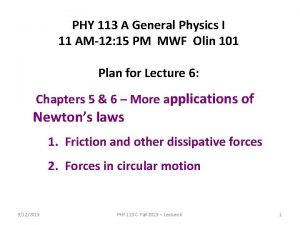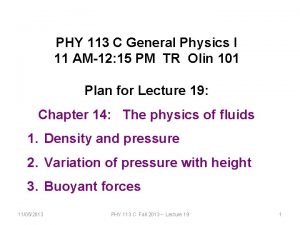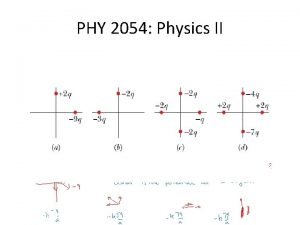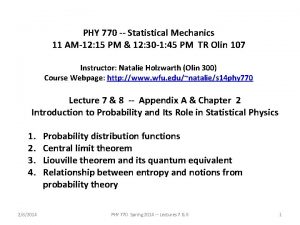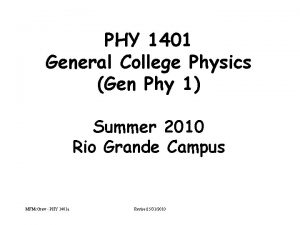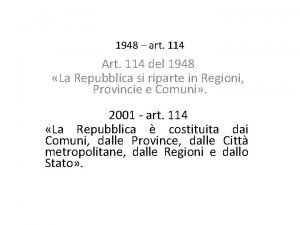PHY 114 A General Physics II 11 AM12
































- Slides: 32

PHY 114 A General Physics II 11 AM-12: 15 PM TR Olin 101 Plan for Lecture 25 (Chapters 44 -45): Some topics in nuclear physics 1. Nuclear binding energies 2. Radioactivity 3. Nuclear reactions 9/10/2021 PHY 114 A Spring 2012 -- Lecture 25 1

9/10/2021 PHY 114 A Spring 2012 -- Lecture 25 2

What do you think of when you hear the phrase nuclear reaction? A. Clean energy source B. Radiation danger C. Nuclear weapons D. No opinion 9/10/2021 PHY 114 A Spring 2012 -- Lecture 25 3

http: //www. nei. org 9/10/2021 PHY 114 A Spring 2012 -- Lecture 25 4

Properties of Nuclei Z Atomic number (number of protons) N Neutron number A = Z+N (number of nucleons) Periodic Table Z 9/10/2021 PHY 114 A Spring 2012 -- Lecture 25 5

Constituents of the nucleus 9/10/2021 PHY 114 A Spring 2012 -- Lecture 25 6

Nuclear notation: Z Atomic number (number of protons)A = A Nucleon number Natural abundance Some examples: 9/10/2021 Natural abundance Some isotopes of C: 91. 754% 98. 93% 99. 275% 1. 07% PHY 114 A Spring 2012 -- Lecture 25 7

Z A % Ref: http: //www. physics. nist. gov/Phys. Ref. Data/Compositions/index. html 9/10/2021 PHY 114 A Spring 2012 -- Lecture 25 8

mass of neutral atom includes Z electrons Z A Mass of nucleus: Msum = Zmp + (A-Z)mn + Zme = 59. 474281 u DM = 0. 5410806 u What should we do with this mass deficit? (A) Chalk it up to inaccuracy of my calculator. (B) Figure that NIST made a mistake. (C) Give up on physics as a quantitative science. (D) Find some meaning associated with DM. 9/10/2021 PHY 114 A Spring 2012 -- Lecture 25 9

mass of neutral atom Z includes Z electrons A Mass of nucleus: Msum = Zmp + (A-Z)mn + Zme = 59. 474281 u DM = 0. 5410806 u = 504. 0135 Me. V /c 2 DM/A = 8. 5426 Me. V /c 2 /nucleon energy associated with nuclear “binding” Another example: DM/A(42 He) = 7. 1 Me. V/c 2/nucleon DM/A(32 He) = 2. 6 Me. V/c 2/nucleon 9/10/2021 PHY 114 A Spring 2012 -- Lecture 25 10

9/10/2021 PHY 114 A Spring 2012 -- Lecture 25 11

Nuclear binding energies per nucleon 9/10/2021 PHY 114 A Spring 2012 -- Lecture 25 12

Neutral atom with Z electrons and Z protons Neutral H atom Neutrons Nuclear forces are so strong that within the nucleus, mass can be converted to energy and visa versa: E = mc 2. 9/10/2021 PHY 114 A Spring 2012 -- Lecture 25 13

9/10/2021 PHY 114 A Spring 2012 -- Lecture 25 14

There must be a strong attraction between nuclear particles 1 fm = 10 -15 m 9/10/2021 PHY 114 A Spring 2012 -- Lecture 25 15

Not all nuclei are stable: Some types of nuclear decay aº 42 He++ Ex: 238 92 U bºe- or e+ Ex: 14 gº (photon) Ex: 12 23490 Th + a 6 C 147 N + e- 12 C* + e- + B 5 6 Measure of radioactive decays: 9/10/2021 PHY 114 A Spring 2012 -- Lecture 25 16

Half-life: When N(t) = ½ N 0: Some units of nuclear decay: 1 Ci (Curie) º 3. 7 x 1010 decays/s 1 Bq (Becquerel) º 1 decay/s 9/10/2021 PHY 114 A Spring 2012 -- Lecture 25 17

Example: Suppose that you have a sample of 1023 14 6 C nuclei each of which has a half-life of 5730 years. How many Curies of radiation is this? 9/10/2021 PHY 114 A Spring 2012 -- Lecture 25 18

9/10/2021 PHY 114 A Spring 2012 -- Lecture 25 19

Effects of radiation in matter Release of energetic particles – a, n, p move atoms in materials e-, e+, g remove or excite electrons cause chemical reactions Quantitative measures of radiation dose rad (“radiation absorbed dose”): amount of radiation that increases the energy of 1 kg of absorbed materials by 0. 01 J. gray (Gy): 1 Gy = 100 rad RBE (“relative biological effectiveness” factor): ratio of biological damage of radiation type to that of g rays rem (“radiation equivalent in man”): rad x RBE sievert (Sv): 1 Sv = 100 rem 9/10/2021 PHY 114 A Spring 2012 -- Lecture 25 20

Some RBE factors Radiation type RBE g rays 1 b particles 9/10/2021 1 -1. 7 n (slow) 4 -5 n & p (fast) 10 a particles 10 -20 heavy ions 20 PHY 114 A Spring 2012 -- Lecture 25 21

Some typical values of dose Source Dose Background radiation 0. 13 rem/year Recommended limit 0. 5 rem/year Diagnostic chest X-ray 0. 01 rem Mammogram 0. 1 rem Fatal dose 400 -500 rem 9/10/2021 PHY 114 A Spring 2012 -- Lecture 25 22

Summary of radiation units: Radiation dose: Amount of radiation absorbed/unit mass 1 Gy = 1 J/kg of absorbed radiation = 100 rad 1 Sv = RBE x (dose in Gy units) = 100 rem relative biological effectiveness 248 x 10 -6 x 0. 85 x 45 = 9. 5 x 10 -3 J 9/10/2021 PHY 114 A Spring 2012 -- Lecture 25 23

Example: A sealed capsule containing the radiopharmaceutical 3215 P with an initial radioactivity of 5. 22 x 106 Bq, is implanted into a 0. 1 kg tumor. Each decay produces e- particles at an energy of 7 x 105 e. V. Determine the absorbed dose in a 10 day period. T 1/2 =14. 26 days. Assume all emitted particles are absorbed. 0. 1 kg dose = RBE x (number of decays) x (energy released)/mass 7 x 105 x 1. 6 x 10 -19 J 1 dose = 4 J/kg = 400 rem = 4 Sv 9/10/2021 PHY 114 A Spring 2012 -- Lecture 25 24

Other facts about nuclei • Nuclei are confined to a very small region of space – typical nuclear radii are 10 -15 m = fm (compare with atomic radius of 10 -10 m) • For some nuclei, there are stable forms with the same Z, but different A (isotopes) • Some nuclei are meta-stable; they transform (decay) into other forms 9/10/2021 PHY 114 A Spring 2012 -- Lecture 25 25

9/10/2021 PHY 114 A Spring 2012 -- Lecture 25 26

Summary of some ideas about nuclear physics • The basic forces that describe nuclei are stronger, shorter range, and more complicated than electromagnetic forces. Nuclear binding energies are typically 8 Me. V/nucleon. • Most nuclear decay processes are described by a simple rate equation For example: 238 U 234 Th + 4 He T 1/2=4. 5 109 yr. • Radiation effects on humans and other sensitive forms of life and devices are due to the light decay products – a, b, g particles Radiation dose: Amount of radiation absorbed/unit mass 1 Gy = 1 J/kg of absorbed radiation = 100 rad 1 Sv = RBE x (dose in Gy units) = 100 rem relative biological effectiveness 9/10/2021 PHY 114 A Spring 2012 -- Lecture 25 27

Guide to nuclear reactions General rules Total A (number of nucleons (Z+N)) is conserved Total charge is conserved protons and neutrons can convert to each other antineutrino positron Neutrinos were first detected in 1956 by Fred Reines and George Cowan, who showed that a nucleus undergoing beta decay emits a neutrino with the electron. Neutrinos are VERY weakly interacting and recent evidence suggests they have a mass of < 0. 1 e. V. 9/10/2021 PHY 114 A Spring 2012 -- Lecture 25 28

Examples of nuclear reactions Used for carbon dating Nucleus captures an electron Positron emission Beta decay followed by gamma decay 9/10/2021 PHY 114 A Spring 2012 -- Lecture 25 29

More nuclear reactions Energy accounting : for a general reaction of the type a+X Y+b energy released as kinetic energy of the products can be calculated: Q=(Ma+MX-MY-Mb)c 2 In this case, Q=(1. 007825+7. 016003 -2*4. 002602) c 2 =17. 348 Me. V 9/10/2021 PHY 114 A Spring 2012 -- Lecture 25 30

Fission: Some history – 1932 James Chadwick (England) discovered neutron Enrico Fermi (Italy) discovered that neutrons could be absorbed by nuclei to form new elements Lise Meitner, Otto Hahn, Fritz Strassmann, Otto Frisch (Germany) discovered fission of U Example: Q» 200 Me. V 9/10/2021 PHY 114 A Spring 2012 -- Lecture 25 31

Other decay products for 9/10/2021 PHY 114 A Spring 2012 -- Lecture 25 32
 Pseudo color image processing
Pseudo color image processing Csit 114
Csit 114 Sas114
Sas114 Catch the excitement
Catch the excitement Taskj-114
Taskj-114 Who wrote psalm 114
Who wrote psalm 114 Po odparowaniu wody z 32 5 g nasyconego roztworu
Po odparowaniu wody z 32 5 g nasyconego roztworu Crm 114 discriminator
Crm 114 discriminator Asl via alassio 36 torino
Asl via alassio 36 torino Fact act
Fact act Snake
Snake Aiaa s-114
Aiaa s-114 Oesd 114
Oesd 114 Imagen del via lucis
Imagen del via lucis Hkr 114 uitm
Hkr 114 uitm Solicitud de licencia articulo 114 y 115 decreto 688/93
Solicitud de licencia articulo 114 y 115 decreto 688/93 Powstanie islamu
Powstanie islamu Decreto 114/2011
Decreto 114/2011 Phy 131 past papers
Phy 131 past papers Phy 231 msu
Phy 231 msu Great orthogonality theorem proof
Great orthogonality theorem proof Rotational statics
Rotational statics Phy theorem
Phy theorem Phy 113 past questions and answers
Phy 113 past questions and answers Phy 131 asu
Phy 131 asu Ddr phy architecture
Ddr phy architecture Phy 205
Phy 205 Nearsighted diverging lens
Nearsighted diverging lens Phy 2049
Phy 2049 Physics 2
Physics 2 Phy
Phy Phy
Phy Atm basics
Atm basics

